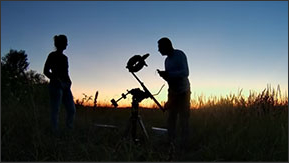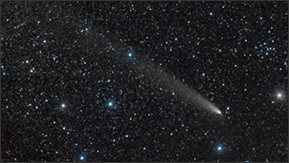
The summer comet of 2020
In the summer of 2020 the bright naked-eye comet C/2020 F3 (NEOWISE) graced our skies. At first only visible in
the morning sky it entered the evening sky by mid-July. At that time it peaked around 2nd magnitude and showed a
bright false nucleus. Read more…

The quest for the gegenschein
The sun's counterglow is kind of a stargazers' legend. Every amateur astronomer has heard about it, only a few of
them have actually seen it and even fewer were lucky enough to make an image of this ghostlike apparition. Read
here the story how we captured it from a remote dark-sky site and how you can find it, too. Read more…

How much lunar eclipse brings out the Milky Way?
During the partial lunar eclipse of July 16, 2019, we experienced exceptionally clear skies at our observing site in
Austria. We took the opportunity to make a series of measurements of the sky brightness in the zenith to find out the
value at which the Milky Way becomes visible to the unaided eye. Read more…

ISS pass in an all-sky view
In May 2017 the International Space Station made a series of convenient evening passes for European stargazers. On
the evening of May 26, 2017, we managed to photograph a nice twilight transit from one of our favorite observing
sites in Austria, about 50 kilometers north of Vienna. Read more…

360° astrophotography
The Ricoh Theta S is a one shot panorama camera. With two fisheye lenses it records a 360° full-sphere panorama
with only one single shot. The recorded images can be further processed and viewed with a player provided by the
manufacturer. We tested the Theta S for astronomical usage and it turned out quite well. Read more…

DSLR astrophotography untracked
With DSLRs and standard camera lenses astrophotography is on the verge of a new epoch, where tracking is no
longer mandatory. After a series of experiments we are now able to present a tried and tested workflow that
guarantees great images of star fields. Read more…

Multimedia presentation in Museum of Natural History Vienna
project nightflight had been invited by the Natural History Museum Vienna to give a presentation about their work on
the evening of November 11, 2015. For this occasion, the members of the astrophotography group designed a special
multi-media presentation focusing on the beauty of the night sky. Read more…

Stargazing sites on La Palma island
Stargazing on La Palma Island is one of the finest astronomical experiences possible. The small volcanic island in the
Atlantic Ocean is part of the European country Spain, has a modern airport, very nice accommodations, good
infrastructure and offers impressively dark skies. Read more…

Sounds of the night
With this project we introduced a brand new category of astro images: Nightscapes accompanied by natural sounds
of the night, recorded during the imaging sessions. The sound of ocean waves, crickets chirping, nocturnal birds and
other nighttime sounds bring the scenes alive. Read more…

First permanent star walk installation worldwide
In 2014, project nightflight opened the first permanent star walk installation worldwide. The Grossmugl Star Walk is a
self-guided tour encouraging astronomical observations with the unaided eye. Nine displays along the trail explain
general astronomical topics in an easy-to-read way. Read more…

Grossmugl sky test
How deep can we go only a few dozen kilometers outside of Vienna? To find the answer we drove to the village
Grossmugl, just 35km north of Vienna's city center and set up our imaging equipment. It was the evening of
February 23, 2014, and the beginning of an average night with mediocre transparency. Read more…

Capturing Venus in bright daylight
With a DSLR, even with a small off-the-shelf digital camera, it is possible to capture Venus in the daylight sky. Here's
how it works: First of all, on the day you shoot Venus the sky should be highly transparent, deep blue in color and
without any haze. Second, you must know exactly where to point your camera. Read more…

Webcam imaging with small telescopes
Most owners of small telescopes sooner or later try webcam imaging with their instruments. It seems an easy,
straightforward and inexpensive way to get started with astrophotography. But their first attempts are almost always
disappointing. Frustrated, they blame it on the small aperture of their telescopes. Read more…

Dive into 3D
Astronomical images not always have to be flat. Planetary rotation, lunar libration or the proper motion of an object
relative to the sky background can be used to achieve a stereoscopic effect. In our example Jupiter's rotation during
15 minutes created the needed offset for a 3-dimensional rendering. Read more…

Video of bright nova in Cassiopeia
In late May 2021, Nova V1405 Cas, which was discovered already in March of the same year, became visible to the
bare eye. We were able to catch a timelapse sequence even though our skies were moderately cloudy at that time.
Watch the video…

Noctilucent clouds timelapse
This eery phenomenon frequently observed from high northern latitudes reached far south this summer of 2021.
Some reports of sightings even came in from Italy that year. From our 49 degrees North location we had several
occurrences and made a timelapse shot during one particularly striking appearance. Watch the video…

Abell 1656
Spring 2023 – time for project nightflight to set out on a new journey and start another project. So, what's in the sky
to explore? Abell 1656, the Coma Galaxy Cluster is a target worthy of our attention. The Coma Galaxy Cluster is no
object for novice stargazers or beginner amateur astronomers. Read more…

Video: The Sky in the Eyepiece
In this clip project nightflight shows you how planets, the moon, nebulae and star clusters will actually look when
observed with common amateur telescopes. The video takes you from dusk till dawn in a stargazing journey that
visits celestial wonders of the night sky. Watch the video…

Leo I, II, III dwarf galaxies with Seestar smart telescope
Smart telescopes will revolutionize amateur astronomy at all levels. Among these instruments the Seestar S50 is
particularly noteworthy. Our example demonstrating the Seestar's capabilities are the three dwarf galaxies Leo I, II,
and III with incredibly low surface brightnesses. Read more…

A study of Comet C/2023 A3
In 2024, we followed Tsuchinshan-ATLAS for more than half a year. During that time we used different equipment to
observe its changing appearance, brightness and development of the tails. We were lucky to be on La Palma island
when the comet was at its brightest. Read more…







